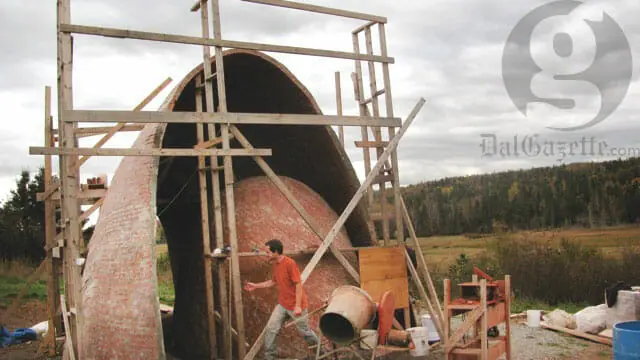Camera obscura part of a science discovery centre project
The little town of Cheverie, N.S., crops up on Highway 215, a meandering route along the Bay of Fundy. Across the road from the Bay, a dome-like structure sits atop an otherwise vacant hill.
The blades of a table saw screech as architecture student Max Schnutgen cuts through one of 30,000 bricks that will become part of Dalhousie architecture’s camera obscura project to be completed next June.
But what exactly is a camera obscura?
“That’s always the question,” Schnutgen says as he contemplates an explanation.
A camera obscura is a dark structure with light coming in only through a pinhole. An image of whatever is outside the structure comes in through the pinhole and is projected on the back wall inside the structure.
The camera obscura in Cheverie will project two images: one of the Bay of Fundy tides, and one of the salt marsh behind the structure.
The images will move in real time, like an animation.
The camera obscura is one of Dal architecture’s Coastal Studio projects. Professor of architecture Ted Cavanagh is the mastermind behind these projects. His research involves “looking at how buildings relate to the environment,” says Cavanagh, “and particularly, how they are built on the coast, in extreme and sensitive environments.”
Cavanagh’s philosophy is to create buildings that benefit the community and are structurally unique.
In technical terms, the camera obscura is a timbrel vault design. “Though generically,” says Cavanagh, “you could call these buildings shells, because they’re like eggshells; they’re thin, and they’re strong.”
Inside the three overlapping eggshells is the “egg” wherein the tidal images will be projected.
Along with being an applied learning experience for the students, the camera obscura is part of the salt marsh restoration process in the area.
An inadequate culvert in the causeway between the Bay and the salt marsh was keeping the river from flowing, explains Cavanagh. “So what used to be a salt-water marsh on the land-side of the causeway ended up getting fresher and fresher.”
The Ecology Action Centre drew attention to the problem in 2004 by educating elementary school kids in the area about salt marsh ecosystems. Student projects generated community awareness, and restoration of the ecosystem has been ongoing ever since.
In 2005, the Department of Transportation and Public Works re-routed the highway and replaced the culvert with a much larger one. “Now the water flows in and out,” says Cavanagh. “And in the process, they’ve restored the marsh back to salt.”
As a Cheverie community member, Cavanagh took a particular interest in incorporating Dal’s Coastal Studio with the salt marsh restoration project.
“About five years ago, we ran some community workshops, and we came up with the idea of a science discovery centre on the site,” says Cavanagh. “And the camera obscura would be part of that.”
The municipal government has shown its support for community initiatives by buying the site for the science discovery centre and pumping money into the project.
The Department of Tourism put $23,000 toward the camera obscura with hopes the structure will attract siteseers.
Cavanagh guesses the camera obscura will cost about $50,000 to complete, some of which is paid for by research grants for Coastal Studio.
The budget factors in free labour from architecture students (who are rewarded with class credits) and paid labour from workers who have been hired on to finish the structure before winter.
Cavanagh predicts the camera apparatus inside the structure will be installed in the spring, with the official opening on Oceans Day in early June.


Recent Comments